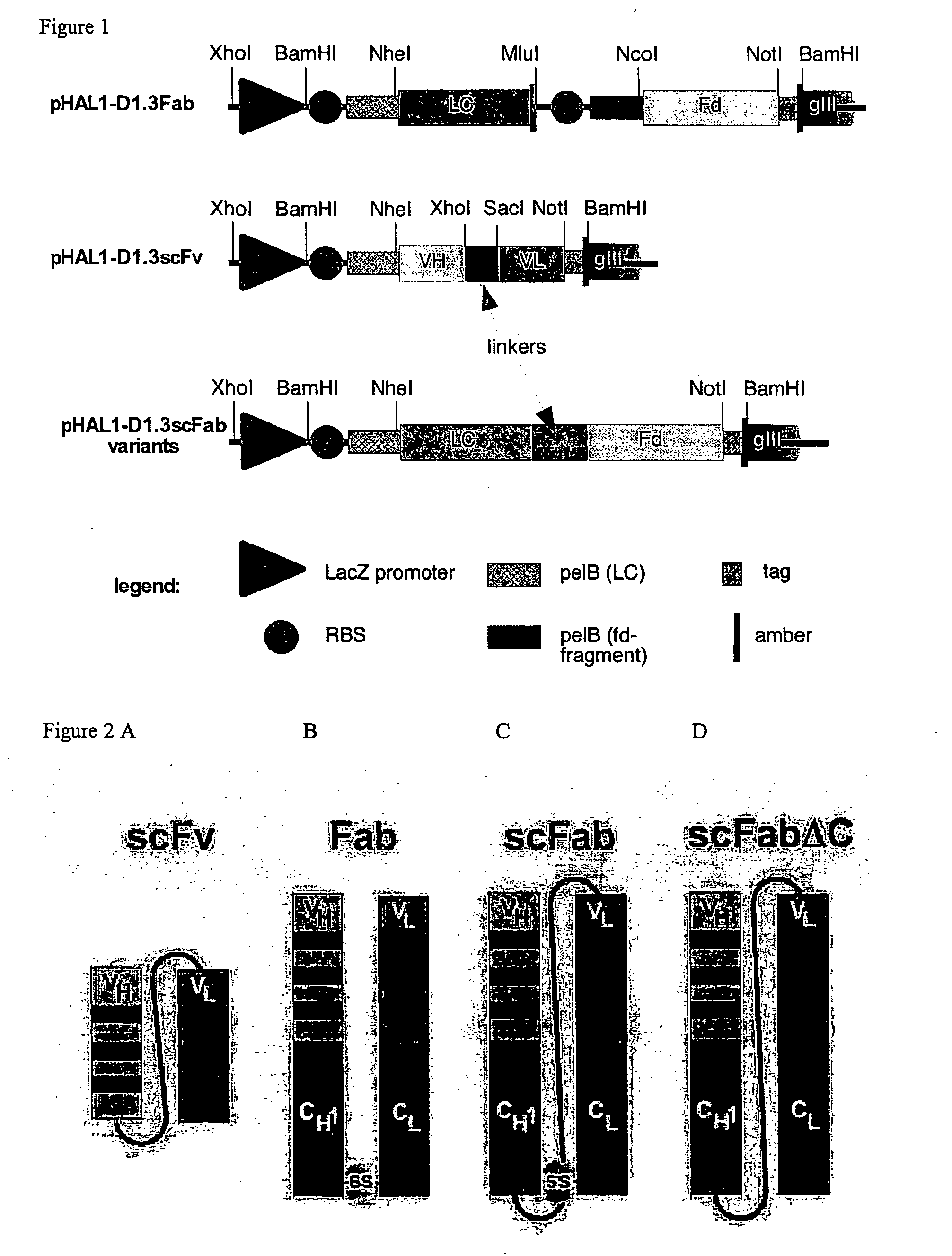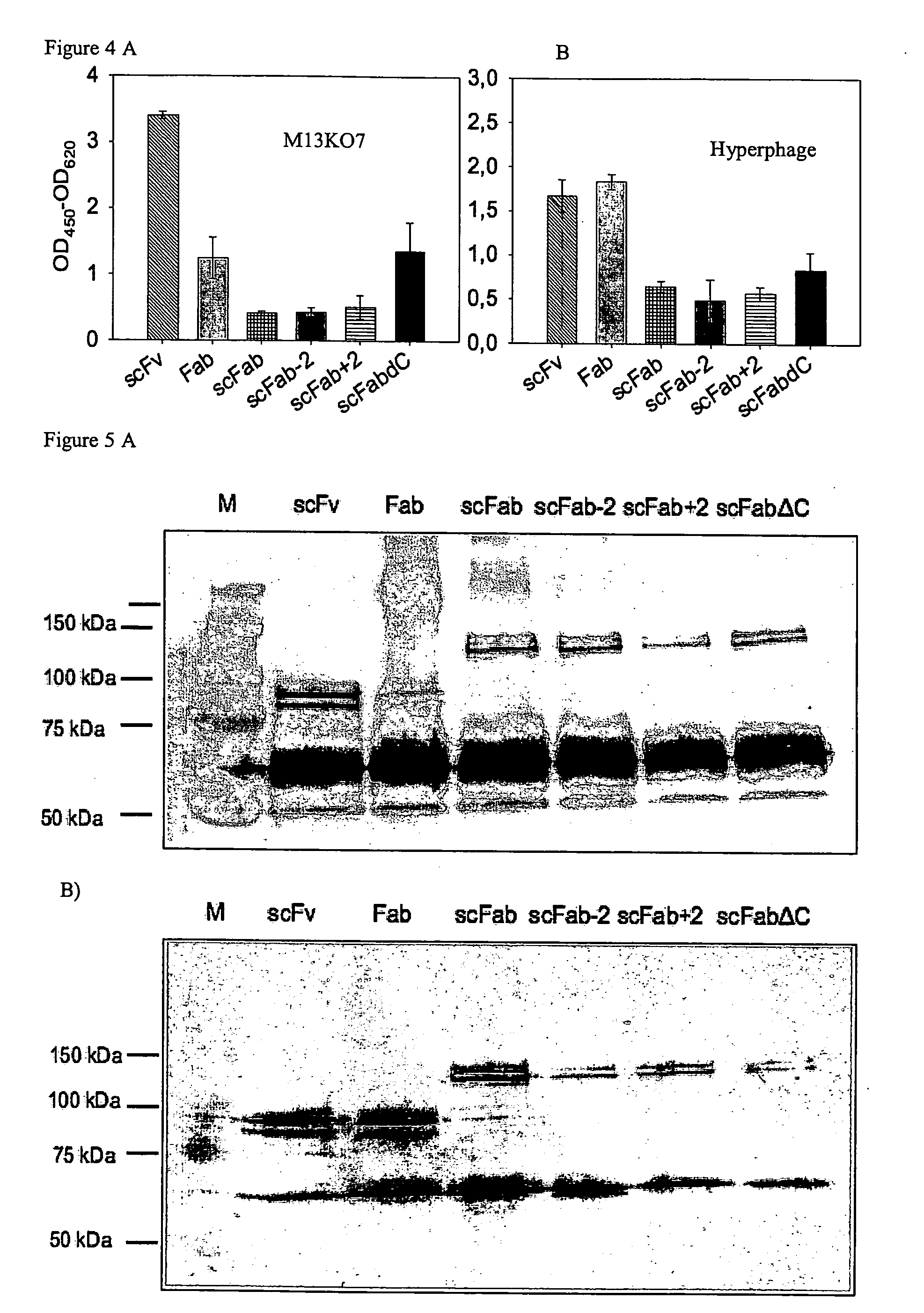Antibody
a technology of antibodies and molecular weight, applied in the field of biotechnology, can solve the problems of laborious processing steps and relatively small molecular size, and achieve the effect of efficient generation and isolation of antibodies
- Summary
- Abstract
- Description
- Claims
- Application Information
AI Technical Summary
Benefits of technology
Problems solved by technology
Method used
Image
Examples
example 2
Expression of Active scFab Antibody by Phase Display
[0064]For production of antibody presenting phage, 50 mL 2× TY medium containing 100 μg / mL ampicillin and 100 μM glucose were inoculated with an overnight culture having an OD600 of about 0.025. Bacteria were incubated at 37° C. under agitation at 250 rpm to an OD600 of about 0.4 to 0.5. Of this culture, 2 mL were infected with 2×1010 helperphage VCSM13 (Stratagene), or Hyperphage (Rondot et al., 2001), incubated for an additional 30 minutes at 37° C. without shaking, followed by 30 minutes at 250 rpm. Infected cells were harvested by centrifugation for 10 minutes at 322× g and the cell pellet was resuspended in 13 mL 2× TY, 100 μg / mL ampicillin and 50 μg / mL kanamycin, containing various glucose concentrations. Phage were produced at 30° C. at 250 rpm for 16 hours. Cells were pelleted for 10 minutes at 10,000× g. The phage in the supernatant were precipitated with one fifth volume of a 20% by weight PEG / 2.5 molar sodium chloride so...
example 3
Analysis of Association of scFab
[0082]Analysis of the association of antibodies was done for comparative constructs scFv, Fab, and for antibodies of the invention, namely scFabΔC and scFab.
[0083]The antibody constructs of the invention were expressed in E. coli and isolated from the periplasmic fraction of the culture by SEC, whereas the comparative antibodies were expressed in mammalian cell culture and isolated from culture supernatant by SEC:
[0084]scFv (comparative): VH-linker-VL
[0085]Fab (comparative): VH-CH I VL-CL, connected by a disulfide bridge
[0086]scFabΔC: VL-CL-linker-VH-CH1, wherein both C-terminal cysteins of the CL and CH1 domains were deleted,
[0087]scFab: VL-CL-linker-VH-CH1,
wherein C1, C2, C5, C6, and C8 indicate SEC fractions. In accordance with SEC fractions, antibodies are designated as dimers or multimers in FIGS. 11 and 12.
[0088]The results of an ELISA as described in Example 2, using increasing concentrations of the respective antibody, are depicted in FIG. 11....
PUM
| Property | Measurement | Unit |
|---|---|---|
| concentrations | aaaaa | aaaaa |
| concentrations | aaaaa | aaaaa |
| temperature | aaaaa | aaaaa |
Abstract
Description
Claims
Application Information
 Login to View More
Login to View More - R&D
- Intellectual Property
- Life Sciences
- Materials
- Tech Scout
- Unparalleled Data Quality
- Higher Quality Content
- 60% Fewer Hallucinations
Browse by: Latest US Patents, China's latest patents, Technical Efficacy Thesaurus, Application Domain, Technology Topic, Popular Technical Reports.
© 2025 PatSnap. All rights reserved.Legal|Privacy policy|Modern Slavery Act Transparency Statement|Sitemap|About US| Contact US: help@patsnap.com



